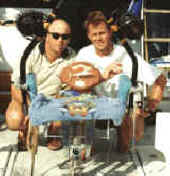Tournament Tactics
by Peter Pakula
 The main pool of thought regarding tournaments is if you're lucky you win if you don't your not. Let's just try and give "Lady Luck" a bit of a hand. Apart from mechanical and electrical, the only problems you're going to have is if you hook up. Solving all this can be quite complex or quite simply a matter of running through a checklist or troubleshooters guide, a bit like the one in the back of your computer software manuals.
The main pool of thought regarding tournaments is if you're lucky you win if you don't your not. Let's just try and give "Lady Luck" a bit of a hand. Apart from mechanical and electrical, the only problems you're going to have is if you hook up. Solving all this can be quite complex or quite simply a matter of running through a checklist or troubleshooters guide, a bit like the one in the back of your computer software manuals.
CHECK YOUR GEAR
This is a bit like a warrior sharpening his sword before a battle, if you check it, you trust it. If you don't you want, and you'll be hesitant in adding the necessary aggression during a protracted fight. The most important single train of thought in all fishing is doing everything you can to catch the fish. The 5,000 different things that can happen to lose a fish may happen anyway without you worrying about it. So check your rollers and reel handles. Why not oil them anyway. Check every piece of gear you are going to use in the battle. If it doesn't pass the test either fix it or replace it.
SET YOUR DRAGS
 Set the drags at 33% of the breaking strain of the line. However, having said that, the speed at which you pull the scales away from the rod and the angle of the rod can change this setting up to 150%. Try this out, set the drag by pulling the scales as quickly as you can, then set it correctly by setting the rod at 45 degrees, and pull the scales slowly. Note that the faster you pull the scale the lighter the drag setting. The amount of pressure exerted by the drag is what sets the hook, keeps it in and tires the fish. Being set a 33% it gives you a margin of error of 67%. This is a huge margin for error. Nowhere else in the world is there a 67% margin for error! In fact, I don't think it exists anywhere else in the solar system. Yet anglers are paranoid about it and even back off their drag from this piddly little setting.
Set the drags at 33% of the breaking strain of the line. However, having said that, the speed at which you pull the scales away from the rod and the angle of the rod can change this setting up to 150%. Try this out, set the drag by pulling the scales as quickly as you can, then set it correctly by setting the rod at 45 degrees, and pull the scales slowly. Note that the faster you pull the scale the lighter the drag setting. The amount of pressure exerted by the drag is what sets the hook, keeps it in and tires the fish. Being set a 33% it gives you a margin of error of 67%. This is a huge margin for error. Nowhere else in the world is there a 67% margin for error! In fact, I don't think it exists anywhere else in the solar system. Yet anglers are paranoid about it and even back off their drag from this piddly little setting.
If there is any sign of the drag being sticky or inconsistent, make sure it's serviced before being used in action. Using an outfit with a bad drag is like using a pistol that jams in a duel.
There is absolutely no reason to back your drag off, not ever. In fact, as soon as the fish settles down after its initial run you should put the drag lever up as far as it will go. On all worthwhile game reels, this will give you a setting of around 65 to 70% the breaking strain of the line, still giving you a massive 30% for error and that’s without counting the cushioning of stretching nylon. Once again, prove this to yourself. Just about all of this stuff is very easy to prove, and once proven you should have the confidence to use it in battle.
Get your favourite Game outfit, or any balanced outfit, set the drag, have a mate take the line some 20 meters away and try and break it through the rod. Even with the drag lever up as far as you can and your fingers locking the spool breaking even 8kg is near impossible. It's true that lines do break during some battles, generally due to large bellies of line being pulled through the water. The higher the drag setting the less belly, the less the chances of busting off.
CHECK LINE, DOUBLES AND SWIVEL KNOTS
If you don't like the look of your knots or any of the line has nicks or abrasions, re-tie them now. It's too late to do anything about it after you hook up. The best knot for a double is the braid or plait, the bimini twist is ok, and the spider hitch is purely for the opposition, never use it yourself. The best knot for connecting hardware such as rings and snaps is the uni-knot.
RIGS, LEADERS, LURES AND HOOKS
These are probably the most important items to check. This is the stuff that directly connects you to the fish. Start with the snaps and swivels, especially the ones on the rods, check them for smoothness and corrosion. If there are any signs of wear and tear replace them. Spares should be stored in a bath of oil such as Tri-Flow and kept in a ziplock plastic bag.
All rigs including shark rigs, live bait rigs and rigged lures should be checked for corrosion on swages, thimbles and hooks. All hook points and barbs should be checked and if necessary sharpened or touched up with a file. All hooks should also be checked just before each use.
Lure skirts also need maintenance. Lure skirts de-plasticise in salt water and exposure to sunlight and fluorescent light ending up quite stiff and faded. This can be helped or avoided by spraying them with plain silicone or petroleum jelly. All terminal gear exposed to salt water should be rinsed with water and detergent and air dried in the shade before storage. Lure bags such as the Pakula Six Pocket have mesh and drain holes being designed to be hung allowing the lures to be hosed off and dried.
THE BOAT GEAR
 One of the benefits of checking the gear before a tournament is that you end up doing a semi stock take. If you can't find the gear to check, then it's unlikely you'll find it when you need it. As you go through the tackle remember where you stow it away.
One of the benefits of checking the gear before a tournament is that you end up doing a semi stock take. If you can't find the gear to check, then it's unlikely you'll find it when you need it. As you go through the tackle remember where you stow it away.
Boat gear is the stuff that no one can find when it's most needed. So give it all a quick check. Tracing gloves should be oiled if they are leather and checked for mildew and rotting.
See if you have enough tags. Check the pole and the applicator needle and that the spare tags are compatible with the applicator. It's a good idea to carry a spare pole.
Tail and gaff ropes should be checked, make sure you have enough to handle the best days fishing you can expect and then add a couple of extras. While you are checking all this gear make sure that the lengths of ropes, gaffs, tag poles, leaders and doubles comply with the rules you'll be fishing under. You shouldn't even have gear that doesn't comply on board during the tournament.
Gimbal buckets and harnesses should be checked. Make sure the clips and adjustment buckle work freely, once again oil them anyway.
Tools such as pliers, side cutters, files, knives, bolt cutters, and swaging tools should all be serviced and once again oiled anyway.
All this gear checking should really just be a matter of course and should not take long. Once you've checked it you should have no concerns about failure or not having the gear at hand. You are just about ready to confidently take advantage of every opportunity that arises.
THE CREW
Game fishing crews are a group of guys who get together to accomplish the common goal of catching fish. In other words a Team. The better the team structure the better the team . Every member should know his position and what they are expected to do in the various situations that arise. Every angler should know how the drag lever and speed shift work on the reels you use. Every angler should know how the harness and gimbal feel when it is fitted correctly. The angler should know how to pump the rod and how much strain they should feel when everything is working properly. These and other situations should be discussed and even practised before you get hooked up.
Some of these are:
-
Who is in charge of checking the drags, hooks, leaders etc?
-
Who knows where the gloves, tags, gimbal, harness. tools etc are stowed?
-
Who chooses and sets the bait or lure pattern?
-
Who's on strike when a rod goes off?
-
Who drives the boat?
-
Who clears the other rods?
-
Where are these rods and gear put once you hook up? (The hooks should never be put on the deck or the cabin floor)
-
Who gets the angler the Gimbal belt and harness and sets them up?
-
Who decides how the fish will be fought?
-
Who traces the fish?
-
Who tags it, and who releases it?
-
Who takes the photos or video?
The way tournaments are set up these days most points are scored on released fish. No matter who wins there's always some aspersions as to the validity of the win. Taking photos or video of each fish caught during the tournament easily solves this. Just make sure there is something to do with the tournament such as the tournament shirt in the photo or video.
Possibly the most important Tournament Team discussion should be on how the Trophies and prizes should be split when you win. This discussion is so important that you should probably write the proposed split down and get all team members to sign it. The lack of this short discussion has caused many great winning teams to break up and in a number of circumstances ended up in court.
TOURNAMENT TACTICS
The team should now be ready for action. The knowledge of tactics and just about everything to do with tournament fishing certainly grows with experience, however, novices blitz the old timers often enough for any entrant to have enough confidence to compete.
Here are a couple of quick points to help out.
-
Set your lure pattern with the largest lures closest to the transom and the smallest towards the tail of the pattern. A good pattern should have a variety of sizes, however, don't mix the types of lures you're using, i.e. don't mix sliced heads with chuggers
-
Use teasers making sure there's bait or lure very close behind them.
-
Once you get a shot from a fish stay in the area, especially if there are any other signs such as bait schools or a temperature change.
-
If you find a significant temperature or colour change in the water work both sides well. Predators are quite often in the colder or dirtier water.
-
Use as light a leader on baits and lures as possible. In tournaments, 300lb is as heavy as you need to go and as light as 80lb for little blacks. Sure you have to check them after each fish and replace as necessary.
-
 Leaders should be about as long as the fish you expect to catch. Granders are only 13 feet long. At the same time don't use leaders much under the length of the fish you expect to catch. The lure should be free to slide away from the fish and stay in the water as the fish jumps.
Leaders should be about as long as the fish you expect to catch. Granders are only 13 feet long. At the same time don't use leaders much under the length of the fish you expect to catch. The lure should be free to slide away from the fish and stay in the water as the fish jumps. -
When you hook up, maintain the boat down current from the fish to stop you drifting over it.
-
Don't fight the fish directly under the boat. If you get in this position drive away from the fish. The higher the angle of the line, the better the chances of raising the fish towards the surface.
-
Get the fish in as quickly as possible. There is only a limited bite time to take advantage of.
-
Push your gear to the limit. It certainly adds a whole new dimension to fishing hearing that line sing in the breeze and it boosts the adrenaline.
Tournament Game and Sports Fishing are team sports. It is a great source of pride to become part of a good team. This can only be achieved with discussions understanding and time to understand the members and gain experience. When you become part of a group that acts as a team it is a great source of pleasure and pride. Being prepared and confident in your own and your team's ability is what it is all about. If you get the shots and get it right enough times you win. Winning is not everything, but it sure beats the alternatives. In reality, after many years of fishing tournaments you no longer fish only to win but to catch up with the mates made through the years, being in those wonderful places they hold tournaments, and just being away with the guys on that ever-changing ocean.
See you at the presentation, up there on the podium.





